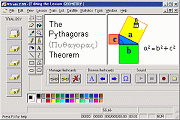
|
|
| Introduction | |
| Registering an OLE server | |
| Choosing a suitable OLE server | |
| Warning! File fragmentation! |
| Like in certain other programs (e.g. Microsoft Word), you can insert multimedia
objects (images, videos, text, sound, etc.) in your VTrain flashcards. In VTrain, you can do this via the "Edit
menu | Insert object" command. This is accomplished by way of OLE (object linking and embedding), a technology developed by Microsoft. |
 |
However, inserting a data object by OLE means that the object is actually controlled by an external application, called the "OLE server", not by VTrain itself. On every Windows system, each file type is assigned a specific OLE server. For example, <*.bmp> files are typically displayed by Microsoft Paint when inserted by OLE.
The problem is, not all applications are full-fledged OLE servers. For example...
- Some OLE servers display the objects in VTrain just the way they are ("direct insertion"), and even allow you to edit them within the VTrain window.
- Some servers allow direct insertion only, but no edition, or they can edit the files only in their own window.
- Some servers do not even allow direct insertion: the objects are displayed in VTrain as mere icons (you have to double click to 'activate' them).
- Sometimes when you copy data from a program and paste them into VTrain, they are pasted in a metafile format because the program of origin is not fully OLE-compatible.
- Some OLE servers even fail to work properly, generating error messages like "a static ActivX object cannot be displayed" when you try to display or activate an object.
For this reason, sometimes you may wish to modify the OLE registration of a file type on your system. See Registering an OLE server
for more information.
For more information about OLE, see the Help file shipped with VTrain.
Legal notice.
Reload this page: http://www.vtrain.net/ole.htm
